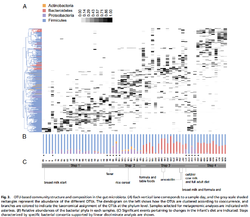The role of Bifidobacterium on the Immune System
Due to Bifidobacterium's dominance in infant’s fecal flora and as well as its probiotic application, it has experienced a surge in popularity by the medical and science realm to better understand its mechanistic properties and implications in human health concerns. In particular, Bifidobacterium longum has become a subject of more studies as its presence in microflora of infants as well as in adults has been intricately linked to protection against diseases. In addition, because Bifidobacterium is present in up to 90% of the total gut microflora in infants but eventually shifts to about 15% in adults, the study on how colonization of these gram-positive anaerobic bacteria is of particular interest (Ménard, et.al. 2008). Studies often concentrate on the mother-to-infant transmission of bacterial colonization in the gut microflora as more knowledge arises on the initial colonization of the flora and its potential impact on the individual’s future health.
Another concern towards better understanding Bifidobacterium is its application and limitations as a probiotic. Probiotics are living microorganisms that affect the hosting individual in a positive manner by regulating mucosal and systemic immunity as well as fortifying the microbial balance in the intestinal tract (Madsen, 2001). Bifidobacterium is one of the popularly marketed lactic acid bacteria, a category that also includes Lactobacillus and Streptococcus.
The gut microflora is of increasing concern for studies as the manner of colonization displays a complex inter-web all relating to the health of the individual. Thus, it is important to continue studying the microflora in all its aspects as well as paying particular attention to Bifidobacterium effects. In addition, more effort is necessary towards controlling the term “probiotics” in how it is marketed into the marketplace as well as teaching more people about the uses.
Transmission of Bifidobacterium

Increasing knowledge of initial gut colonization show a pattern of facultative aerobes such as Enterobacteriaceae initially colonizing the microflora, essentially setting the path towards colonization from anaerobic bacterias such as Bifidobacterium longum (Makino, et.al. 2013). This pattern in colonization is interesting in sorts because of its implications of the microbial stimulation that can impact various changes to the development of the immune system.
As studies are conducted on the vertical transmission of microbial colonization, factors such as delivery mechanism have come into scrutiny. Makino et.al. observed a vertical transmission of Bifidobacteria, including B. longum, as they were able to obtain and identify the same strains in both mother and infant in vaginally delivered infants (2013). However, studies have indicated that the initial colonization of Bifidobacteria is present particularly only in vaginally delivered infants; with a remarkable difference from those delivered cesarean (Makino et.al., 2013, Miakami, et.al. 2012 and Biasucci, et.al. 2010). Interestingly, several studies have continuously observed B. longum to be a prominent bacterial species that is initially found in the colonization of the newborn microflora.
While there has been an increase in correlation of vertical transmission of Bifidobacterium from mother-to-infant, other non-maternal factors have been observed in the establishment. These factors include breast-feeding or formula feeding as well as horizontal transmission from environmental factors such as the hospital setting (Mikami et.al. 2012).
Implications towards immunity and other health diseases
While studies on cesarean delivery’s impact on an individual’s immunity have been conducted, further research needs to be engaged to strengthen the relationship. Biasucci et.al. recognized that reduced exposure to a variety of microbes in the environment has been linked to the delay of postnatal maturation of the immune system and thus slower rate to obtaining an optimal balance between TH1 And TH2-like immunity (2010). In addition, naturally born individuals are speculated to have a defense mechanism against Methicillin-resistant Staphylococcus aureus (MRSA) colonization as vaginal microbes temporarily occupy site-specific niches until the eventual community is developed (Dominguez-Bello, et.al., 2010).
Ménard et.al. proved that Bifidobacterium’s ability to stimulate the immune is species specific whereas its influence of the orientation is strain-specific in regards to the balance of T-helper (TH1)/TH2 lymphocyte (2008). The ability to determine the onset of allergic diseases is the mechanism in which T-helper 1 (TH1)/TH2 lymphocyte responds to antigens with a TH2 phenotype (Ménard, et.al. 2008). Bifidobacteria was linked to several different response pathways in the immune system. Dong et.al. conducted their studies based on minimizing and supplementing the presence of Bifidobacteria against a control (2010). Their study proved that the intestinal colonization is able to aid expression of IL-12 in the gut, influence T-cell development in the thymus, and aid the development of Treg response in the gut (Dong et.al., 2010).
Some explain the recent allergy epidemic in the past decades can be explained by CS delivery mechanism, in particular the transmission of Bifidobacterium, as a positive correlation between CS delivery and sensitization to allergy was found in infants with strong family history of allergies. Infants born from mothers with allergies are at a greater risk to obtain an eventual food allergy. An association to subsequent food allergy was at a 4 to 7-fold increase for individuals who were born through cesarean sections from women with various allergies (Eggesbø et.al., 2003). Laubereau, et.al. also conducted a study using hen’s egg as the main IgE allergen marker which proved that infants born through cesarean section were more susceptible to later sensitization (2004).
Uses as a Probiotic
References
Edited by (Christina Kang), a student of Nora Sullivan in BIOL168L (Microbiology) in The Keck Science Department of the Claremont Colleges Spring 2014.

